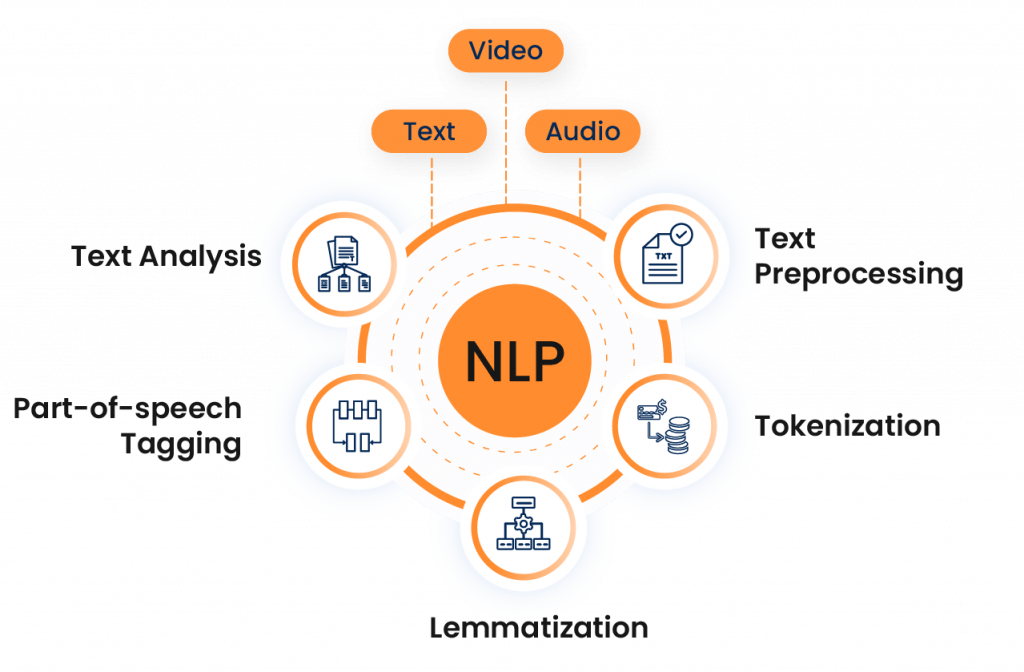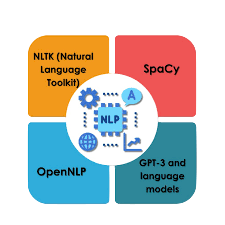
- Introduction to NLP
- History and Evolution of NLP
- Key NLP Tasks (Tokenization, POS Tagging, etc.)
- NLP vs Text Mining
- Important NLP Algorithms
- NLP Tools and Libraries (NLTK, spaCy)
- Applications of NLP (Chatbots, Translation)
- Challenges in NLP (Ambiguity, Sarcasm)
- Conclusion
Introduction to AI Salary Trends
Natural Language Processing (NLP) is a field of artificial intelligence (AI) that focuses on the interaction between computers and human languages. The goal is to enable machines to understand, interpret, and generate human language in a way that is both meaningful and useful. NLP lies at the intersection of computer science, linguistics, and Machine Learning Training , playing a critical role in modern AI systems such as chatbots, virtual assistants, and translation engines.Natural Language Processing (NLP) is a branch of artificial intelligence (AI) that focuses on enabling computers to understand, interpret, and generate human language. It bridges the gap between human communication and machine understanding, allowing computers to process language in a way that is both meaningful and useful. NLP combines computational linguistics with machine learning and deep learning techniques to analyze text and speech data.NLP powers many everyday applications such as chatbots, virtual assistants, machine translation, sentiment analysis, Applications of NLP and spam detection. In fraud detection, NLP can be used to identify suspicious language patterns in emails, insurance claims, or customer communications, helping to uncover fraudulent intent or behavior.The Important NLP Algorithms process typically involves several steps: text preprocessing (tokenization, stemming, and lemmatization), syntactic analysis (part-of-speech tagging and parsing), and semantic analysis (understanding meaning and context). Advanced models like BERT and GPT use deep learning to understand the context of words in a sentence, artificial intelligence improving the accuracy of NLP applications.As the volume of text data continues to grow rapidly, NLP plays an increasingly important role in extracting insights, automating tasks, and enhancing decision-making in business, healthcare, virtual assistants, security, and beyond.
Ready to Get Certified in Machine Learning? Explore the Program Now Machine Learning Online Training Offered By ACTE Right Now!
Factors Affecting AI Salaries
AI salaries vary widely based on several key factors:
- Experience and Skill Level: Entry-level AI professionals earn significantly less than those with 5+ years of experience.Specialized skills (e.g., computer vision, NLP, reinforcement learning) command higher salaries.
- Educational Background: Advanced degrees (Master’s, PhDs) often translate into higher starting salaries, especially in research-oriented roles.
- Geographic Location: Salaries differ significantly by country, city, and even urban vs rural regions.
- Industry: AI roles in finance, healthcare, and defense typically pay more than those in academia or non-profits.
- Company Size and Reputation: FAANG companies (Facebook, Apple, Amazon, Netflix, Google) offer lucrative packages.Startups may offer lower base pay but compensate with stock options and bonuses.
- Job Role: Research Scientists often earn more than Data Analysts due to the complexity and research-intensive nature of their work.
History and Evolution of NLP
The evolution of NLP can be traced through several stages:
- 1950s–1960s: Early rule-based systems using symbolic logic and hand-crafted rules. The focus was on syntax and grammar.
- 1970s–1980s: Development of more sophisticated parsing techniques and the use of formal grammars like context-free grammar.
- 1990s: Introduction of statistical models, such as Hidden Markov Models (HMMs), which marked a shift from rules to data-driven methods.
- 2000s: The rise of machine learning, especially supervised learning, for NLP tasks like part-of-speech tagging and named entity recognition.
- 2010s–Present: Deep learning and neural networks revolutionized NLP. Word embeddings (Word2Vec, GloVe) and transformer architectures (BERT, GPT) have become dominant.
This historical development highlights the transition from symbolic to statistical and finally to neural approaches in NLP.
To Explore Machine Learning in Depth, Check Out Our Comprehensive Machine Learning Online Training To Gain Insights From Our Experts!
Key NLP Tasks
NLP involves a wide range of tasks designed to process and analyze natural language. Key tasks include:
- Tokenization: Splitting text into individual units (words, subwords, or characters).
- Part-of-Speech (POS) Tagging: Identifying the grammatical category of each word.
- Named Entity Recognition (NER): Extracting entities like names, dates, and locations.
- Parsing: Analyzing the grammatical structure of sentences.
- Sentiment Analysis: Determining the sentiment or emotional tone of text.
- Language Modeling: Predicting the next word in a sequence or generating coherent text.
- Text Classification: Categorizing documents into predefined labels.

These foundational tasks form the building blocks for more complex NLP applications.
NLP vs Text Mining
Natural Language Processing (NLP):
- Definition: A branch of artificial intelligence that enables Machine Learning Training to understand, interpret, and generate human language.
- Goal: To understand the structure and meaning of language through computational methods.
- Scope: Involves tasks such as tokenization, part-of-speech tagging, named entity recognition, sentiment analysis, machine translation, and speech recognition.
- Applications: Chatbots, voice assistants, machine translation (e.g., Google Translate), grammar checkers, and sentiment analysis in customer feedback.
- Definition: The process of deriving useful insights, patterns, and knowledge from unstructured textual data.
- Goal: To extract structured information and discover hidden patterns from large volumes of text.
- Scope: Uses NLP techniques as tools to perform tasks like topic modeling, document clustering, keyword extraction, and trend analysis.
- Applications: Market research, competitive analysis, fraud detection, and academic literature reviews.
- NLP focuses on language understanding (how language works and is structured).
- Text mining focuses on knowledge extraction (what useful information can be gained from text).
Text Mining:
Key Difference:
In essence, NLP provides the tools, and text mining applies them to extract actionable insights.
Looking to Master Machine Learning? Discover the Machine Learning Expert Masters Program Training Course Available at ACTE Now!
Important NLP Algorithms
Several machine learning algorithms have been adapted for Natural Language Processing tasks:
- Naive Bayes: Effective for spam detection and sentiment classification.
- Support Vector Machines (SVMs): Used for classification tasks such as topic identification.
- Decision Trees and Random Forests: Useful for text classification.
- Hidden Markov Models (HMMs): Applied in POS tagging and speech recognition.
- Recurrent Neural Networks (RNNs): Suited for sequence modeling.
- Long Short-Term Memory (LSTM): Handles long-range dependencies in text.
- Transformers: State-of-the-art architecture for many NLP tasks.
These algorithms power various applications, enabling machines to learn from and make decisions based on text data.
NLP Tools and Libraries
Important NLP Algorithms has benefited from a rich ecosystem of tools and libraries that make development easier:
- NLTK (Natural Language Toolkit): A comprehensive library for teaching and prototyping.
- spaCy: Industrial-strength NLP library with excellent performance.
- TextBlob: Simplified NLP for beginners.
- Stanford CoreNLP: Java-based tools for advanced NLP processing.
- Gensim: Specialized in topic modeling and document similarity.
- Transformers (by Hugging Face): Pretrained transformer models like BERT, GPT, RoBERTa.

These tools provide pre-trained models, easy-to-use APIs, and scalable solutions for real-world NLP applications.
Preparing for Machine Learning Job Interviews? Have a Look at Our Blog on Machine Learning Interview Questions and Answers To Ace Your Interview!
Applications of NLP
Applications of NLP is embedded in numerous real-world applications that impact our daily lives:
- Chatbots and Virtual Assistants: Used in customer support (e.g., Alexa, Siri). Machine Translation: Google Translate, DeepL, and others use NLP to translate across languages.
- Speech Recognition: NLP converts spoken words into text (e.g., in voice assistants).
- Document Summarization: Automatic summarization for news, legal documents.
- Spam Detection: Filtering unwanted emails using classification algorithms.
- Sentiment Analysis: Monitoring brand reputation on social media.
- Text-to-Speech and Speech-to-Text: Converts between spoken and written language.
These applications showcase the versatility and value of Natural Language Processing NLP in both personal and enterprise contexts.
Challenges in NLP
Despite its progress, NLP faces significant challenges:
- Ambiguity: Words and sentences can have multiple meanings (e.g., “bank”).
- Sarcasm and Irony: Difficult for machines to detect due to context dependence.
- Context Understanding: Capturing long-range dependencies and subtle nuances. vData Scarcity: High-quality labeled data can be hard to obtain.
- Multilingual Support: Handling code-switching and less-resourced languages.
- Bias and Fairness: Pretrained models may reflect and propagate societal biases.
These challenges drive ongoing research and innovation in the field.
Conclusion
NLP is rapidly evolving and becoming a cornerstone of AI-powered solutions. From parsing text to holding meaningful conversations, it enables Machine Learning Training to bridge the gap between human communication, Applications of NLP and digital systems. The integration of deep learning, especially transformer-based models, has propelled NLP to new Natural Language Processing. Important NLP Algorithms technology matures; virtual assistants’ ability to understand human language will only deepen, making interactions with machines more natural, intuitive, and artificial intelligence. Investing in this field whether through research, education, or application offers vast opportunities in both technology and business landscapes.




